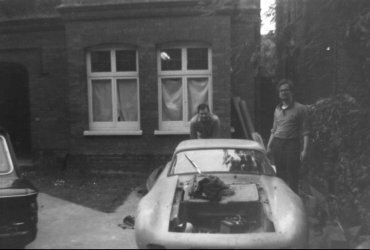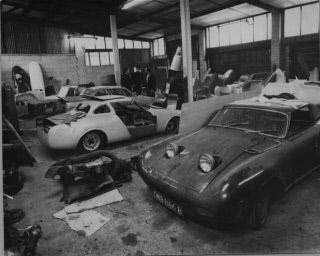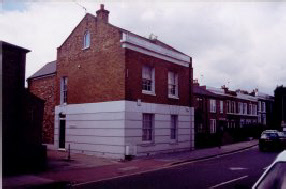
History of the Davrian marque
The Davrian marque was conceived by structural engineer Adrian Evans when he first saw a Hillman Imp in 1963, prior to its release for sale to the public. He built the first prototype at his house in Grove Park, South London in early 1965, using the floorpan from a crashed Imp (see addendum below), and this was followed by a further two plywood prototypes. Subsequent cars, based on these prototypes, utilised fibreglass construction.

Adrian Evans and Gary Lamb with the prototype Davrian outside the house at Grove Park
In 1967, Adrian formed Davrian Developments Ltd. and production of the cars moved to 65 North Street, Clapham. The earliest cars were open-

Inside the workshop at 65 North Street, Clapham


65 North Street (as it is today)
Construction of the cars is based upon a fibreglass monocoque body shell, the sills and voids of which are filled with polyurethane foam to provide additional rigidity. Imp suspension components are utilised both front and rear, although some later cars featured Davrian fabricated swinging and trailing arms. The majority of the cars are rear-
Early cars retained the rear-
The first Davrians were all supplied in component form, the kits coming either as body shells or rolling chassis less engines. However when Purchase Tax was replaced by VAT, cars were also supplied ready-
It is fair to say that the majority of Davrians have probably seen some competition duty, and in its heyday Davrian ran its own works team in modsports racing. During the '70s and '80s, Davrians, in the hands of the likes of Pat Longhurst and Bob Jarvis, proved extremely dominant in modsports and kitcar racing, often performing giant-
In late 1975, Davrian moved from Clapham to Wales,. Unfortunately the premises in Felinfach into which Davrian had planned to move failed to materialise and for four years production was split between Adrian's house in Llwynygroes and John Dark's garage in Pontyfendigaid where the cars were assembled. It was here that the MK7a was developed for rallying with the help of funding from John Dark. Eventually, however, with help from the Development Board for Rural Wales they moved into Unit 13 on the Lampeter Industrial Estate, and it was here that the Mk8 and Davrian Dragon (Ford CVH-

Outside Davrian's Lampeter premises in September 1982
Will Corry of Corry Cars in Northern Ireland bought the assets, intending to produce an up-
The Corry Cultra was not a commercial success and Tim Duffee went on to found Team Duffee Engineering which manufactures the Darrian T9 and T90 mid-
Adrian Evans, who had moved away from cars to manufacture fibreglass two and four-
Update to the Davrian Story
In 2019 the NDR received the following e-
“I’m very pleased to see that there is still interest in the Davrian marque. I am David Clarke, Adrian Evans’ partner at the inception of Davrian Developments. I remember well the evening, we constructed the name of Davrian, the conjunction of our two names David and Adrian! In fact, although I joined Adrian and injected capital into the business whilst also providing my modest skills as a fibreglass boat-
Reading my your very interesting and informative newsletter there seems to be some guesswork on the early days of the Davrian: there was never an Imp floor pan used on any prototype as that would have compromised Adrian’s brilliant idea of a eventual all fibreglass structural monocoque car. In fact the first pan was constructed from an 8’ x4’ sheet of marine ply . I could give you a lot more correct information of these very early days of the car, if it is of interest to you and your fellow enthusiasts. In fact l could write a book!
Adrian was inceptive engineer, one in a million, but he could be quite difficult to work with. I was only 18 at the time and a lot of life lessons had still to be learnt.
l Left London and Davrian in December 1969, for an entirely new life in Cornwall, which would never have happened without the influence of Adrian and the Davrian experience, but also with a debt of £60, consisting of unpaid national insurance payments. However it was a marvellous time to be a teenage car builder in swinging London, so NO REGRETS.” David Clarke.


NDR1 Site generated using SERIF WebPlus X7
©John E.F.Rawlins (New Davrian Register) 2021
